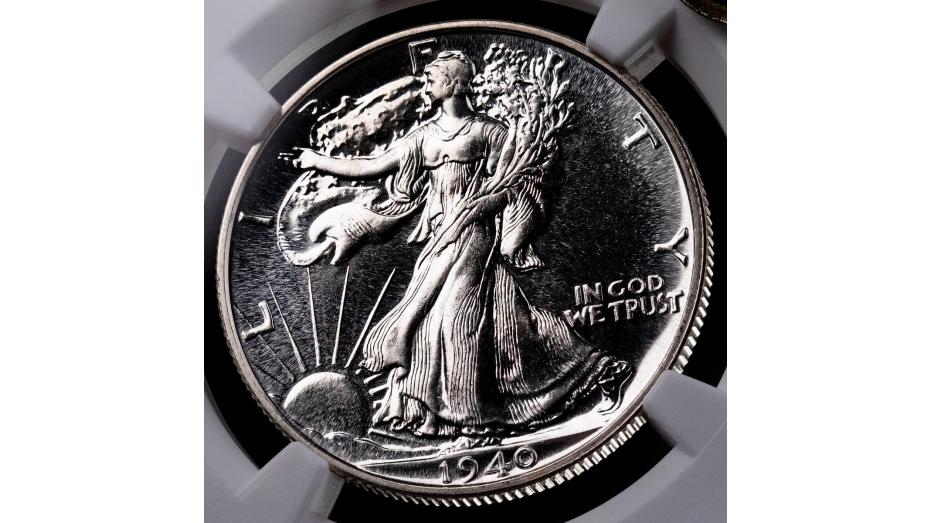Ladies of Liberty: Audrey Munson’s Life in Art
The Walking Liberty design used on the half dollar and the American Silver Eagle, designed by Adolph Weinman, is one of the most popular designs among numismatists. While the name of the designer is extremely well-known, the woman who posed for the sculpture has faded into obscurity. In the early 1900s, she was known by many titles including Miss Manhattan, American Venus, Panama-Pacific Girl, and the world’s first super-model, but her name was Audrey Munson. Her beauty was so inspiring that she was soon the subject of sculptures, paintings, drawings, medals, coins, and even films.
Born in 1891, Audrey Munson had an unassuming early life until her parents divorced when she was 8 years old. Seeking a place where they could live a better life, Audrey and her mother moved to New York City. As a teen, Audrey performed with several dancing and vaudeville acts. In 1908, while window shopping, Audrey was stopped by a photographer who politely invited her up to his studio. With her mother’s permission, Audrey posed for him and was introduced to his neighbor Isidore Konti, who was associated with the Beaux-Arts style. From there, Audrey Munson became the favorite model of the Beaux-Arts collection of artists.
Audrey Munson gained fame as a muse modeling for artists such as John Flanagan, Robert Ingersoll Aitken, and Daniel Chester French. As a model for Isidore Konti, Munson posed for his marble statues “The Three Graces” and “Mother and Child: The Bath.” When viewed, these pieces of Grecian-style art allow Audrey Munson’s classic beauty to shine through the work.
Sculptor Daniel Chester French, most famous for the statue of Abraham Lincoln that sits inside the Lincoln Memorial, was a mentor of Adolph Weinman who also had Munson pose for him. French’s contributions to the art world include a pair of statues representing Brooklyn and Manhattan that were on either side of the Brooklyn Bridge. Audrey Munson posed for these statues, and now they stand in front of the Brooklyn Museum.
One day, Isidore Konti gave Audrey Munson a letter of recommendation to pose for famed sculptor Adolph Weinman. It was at this fateful meeting that simply seeing the figure of Munson inspired Weinman to create his classic sculpture “Descending Night.” Audrey Munson recounted the time spent in Weinman’s studio on Tenth Street, where he said to her, “You look as if you should pose all the time. You are quite Grecian and yet you seem to have the warmth of emotion the modern public likes to see in its models.”
One of the earliest collaborations between Weinman and Munson was “Civic Fame,” the gilded bronze sculpture that sits atop the Manhattan Municipal Building. The figure stands upon a globe with her left arm outstretched holding a mural crown representing the five boroughs of New York City. “Civic Fame” was commissioned to celebrate the consolidation of the five boroughs of New York and is known as the largest statue in Manhattan, not counting the Statue of Liberty.
Weinman’s “Descending Night” was displayed at the Panama-Pacific International Exposition, alongside Daniel Chester French’s “The Genius of Creation,” Isidore Konti’s Fame and Victory relief figures, and the Medal of Award by John Flanagan, all of which used Audrey Munson as a model. In fact, three-fifths of the sculpture on display at the exposition featured Munson as a model. This came about as the acting-chief of the sculpture program was Alexander Stirling Calder who would favor using Munson for his work. At the same time, Munson could also be seen on the Panama-Pacific $50 Gold Commemorative Coin designed by Robert Ingersoll Aitken. With all of these appearances, Audrey Munson became known as the Panama-Pacific Girl.
In 1915, the U.S. Mint was busy striking the commemorative coins for the Panama-Pacific Exposition as well as searching for new designs for the dime, quarter, and half dollar. Adolph Weinman was one of the three artists that the Mint asked to submit designs for the coins. His designs for the dime and half dollar were accepted while Hermon A. MacNeil’s Standing Liberty was used for the quarter. While MacNeil’s Standing Liberty Quarter was soon replaced by Flanagan’s Washington quarter, both of Weinman’s designs would last over 30 years. For the half dollar, Weinman portrayed Liberty striding towards the rising sun with her arm outstretched. It is no surprise that while Weinman was already working with Munson, she would inspire his version of Liberty.
The story of Audrey Munson is one of a beautiful woman who was noticed by many, but only a few truly knew her. Her name should be known as she inspired countless artists, and her likeness can still be seen on sculptures in New York, Florida, Georgia, and even in England. With a classic Grecian look, Audrey Munson inspired the longest-lasting design featuring Lady Liberty on American coinage with the Walking Liberty Half Dollar and then the American Silver Eagle.






